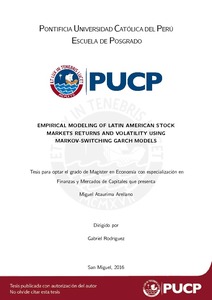Empirical modelling of latin american stock markets returns and volatility using Markov - Switching garch models
Abstract
Using a sample of weekly frequency of the stock markets returns series, we estimate
a set of Markov-Switching-Generalized Autoregressive Conditional Heterocedastic-
ity (MS-GARCH) models to a set of Latin American countries (Argentina, Brazil,
Chile, Colombia, Mexico and Peru) with an approach based on both the Monte Carlo
Expectation-Maximization (MCEM) and Monte Carlo Maximum Likelihood (MCML)
algorithms suggested by Augustyniak (2014). The estimates are compared with a stan-
dard GARCH, MS and other models. The results show that the volatility persistence
is captured di¤erently in the MS and MS-GARCH models. The estimated parameters
with a standard GARCH model exacerbates the volatility in almost double compared
to MS-GARCH model. There is di¤erent behavior of the coe¢ cients and the variance
according the two regimes (high and low volatility) by each model in the Latin Amer-
ican stock markets. There are common episodes related to global international crises
and also domestic events producing the di¤erent behavior in the volatility of each time
series. Utilizando una muestra de frecuencia semanal de series de retornos de los mercados bursátiles, se estima un conjunto de modelos autorregresivos heterocedásticos condicionales generalizados con cambios de régimen Markov (MS-GARCH, por sus siglas en inglés) a un conjunto de países de América Latina (Argentina, Brasil, Chile, Colombia, México y Perú) con un enfoque basado en los algoritmos de Esperanza-Maximización de Monte Carlo (MCEM, por sus siglas en inglés) y de Máxima Verosimilitud de Monte Carlo (MCML, por sus siglas en inglés) sugeridos por Augustyniak (2014). Las estimaciones son comparadas contra un modelo GARCH estándar, un modelo de cambio de régimen Markov (MS, por sus siglas en inglés) y otros modelos más. Los resultados muestran que la persistencia de la volatilidad es capturada de manera diferente en los modelos MS y MS-GARCH. Los parámetros estimados con un modelo GARCH estándar exacerban la volatilidad a casi el doble en comparación el modelo MS-GARCH. Se evidencia un diferente comportamiento de los coeficientes y la varianza según los dos regímenes (alta y baja volatilidad) en cada uno de los modelos en los Mercados Bursátiles Latinoamericanos. Hay episodios comunes relacionados con las crisis internacionales globales así como eventos domésticos (nacionales) que producen un diferente comportamiento de la volatilidad en cada serie de tiempo.
Temas
Bolsa de valores--América Latina
Bolsa de valores--Modelos estadísticos
Bolsa de valores--Tasa de rendimiento
Bolsa de valores--Modelos estadísticos
Bolsa de valores--Tasa de rendimiento
Para optar el título de
Maestro en Economía
Collections
The following license files are associated with this item:






